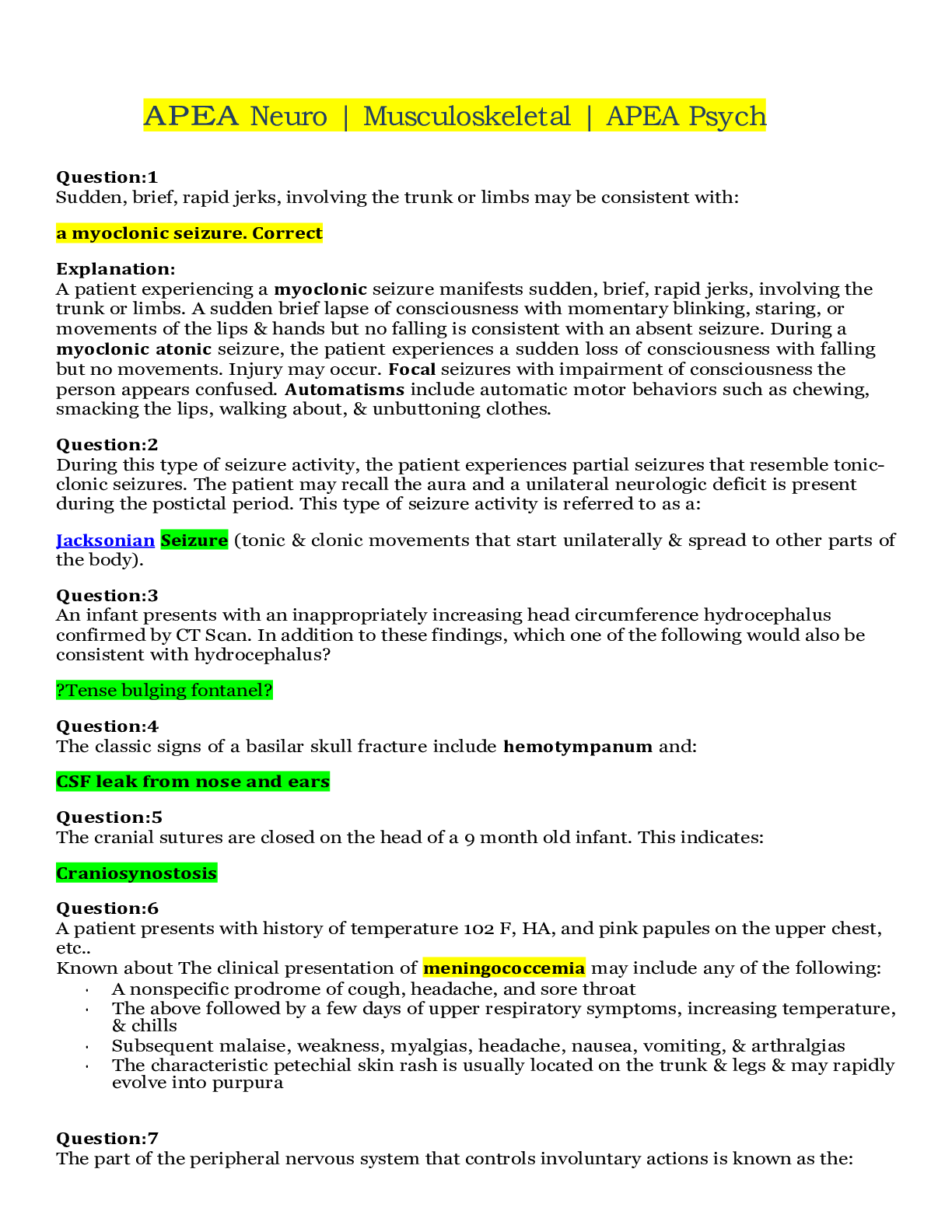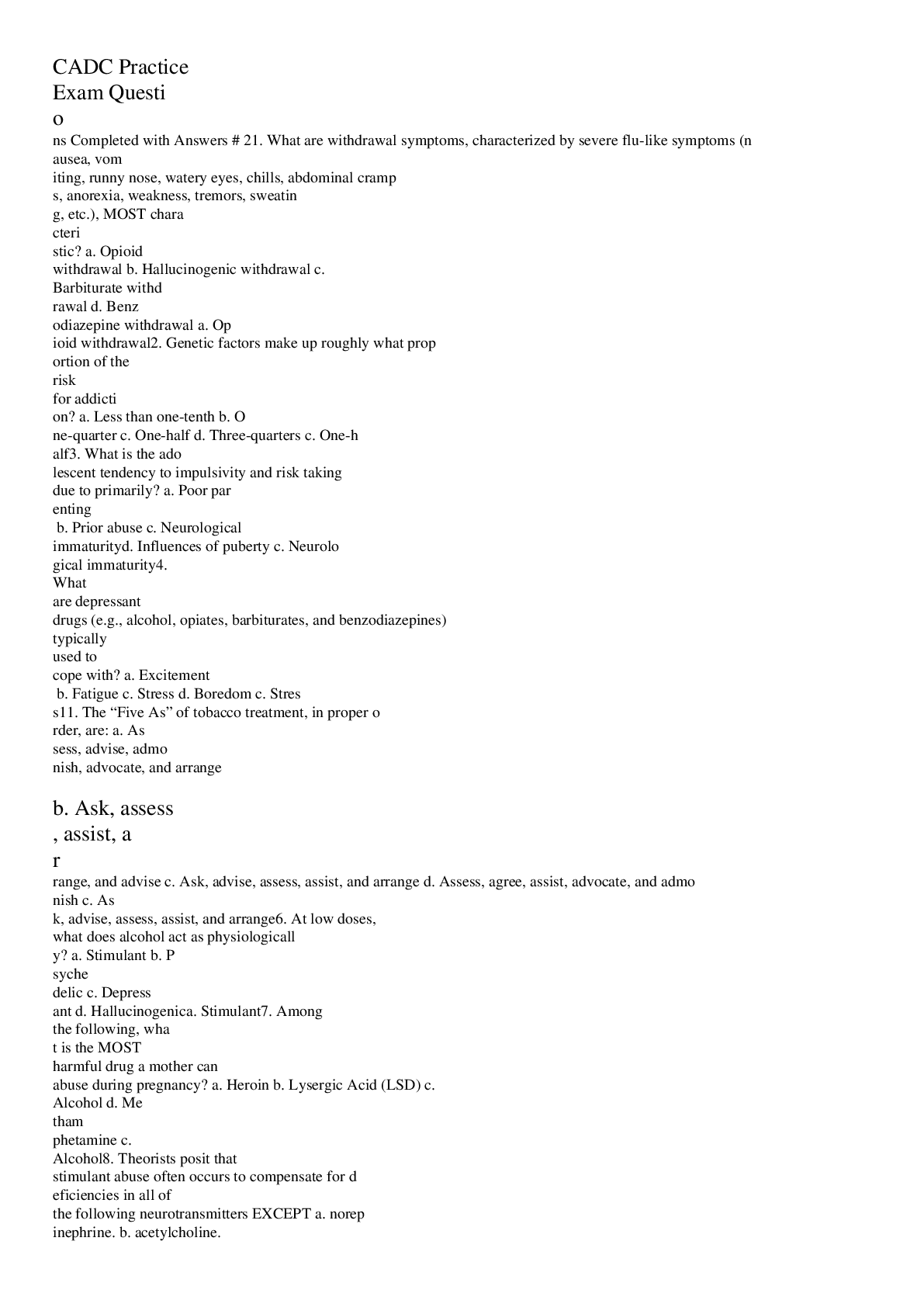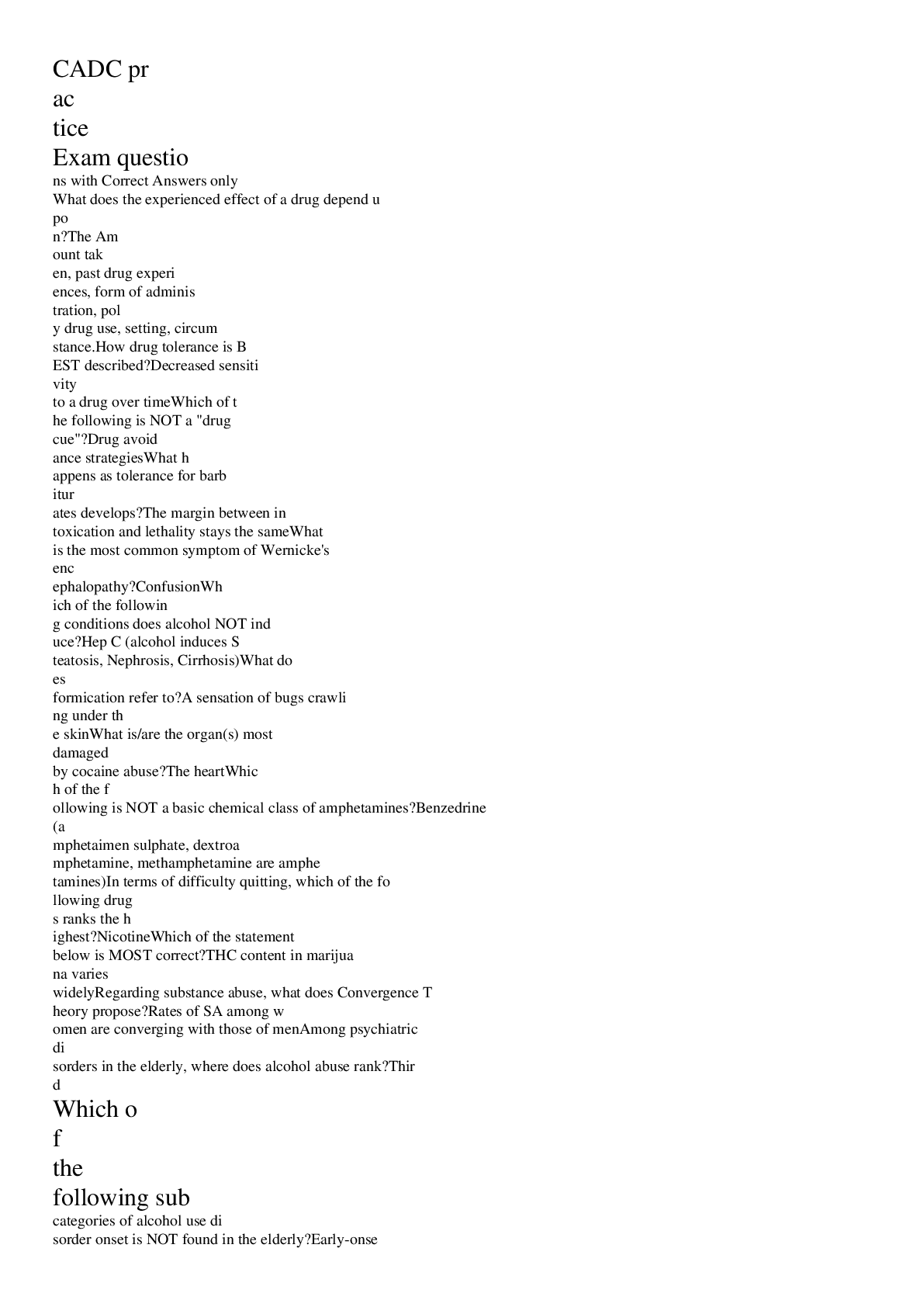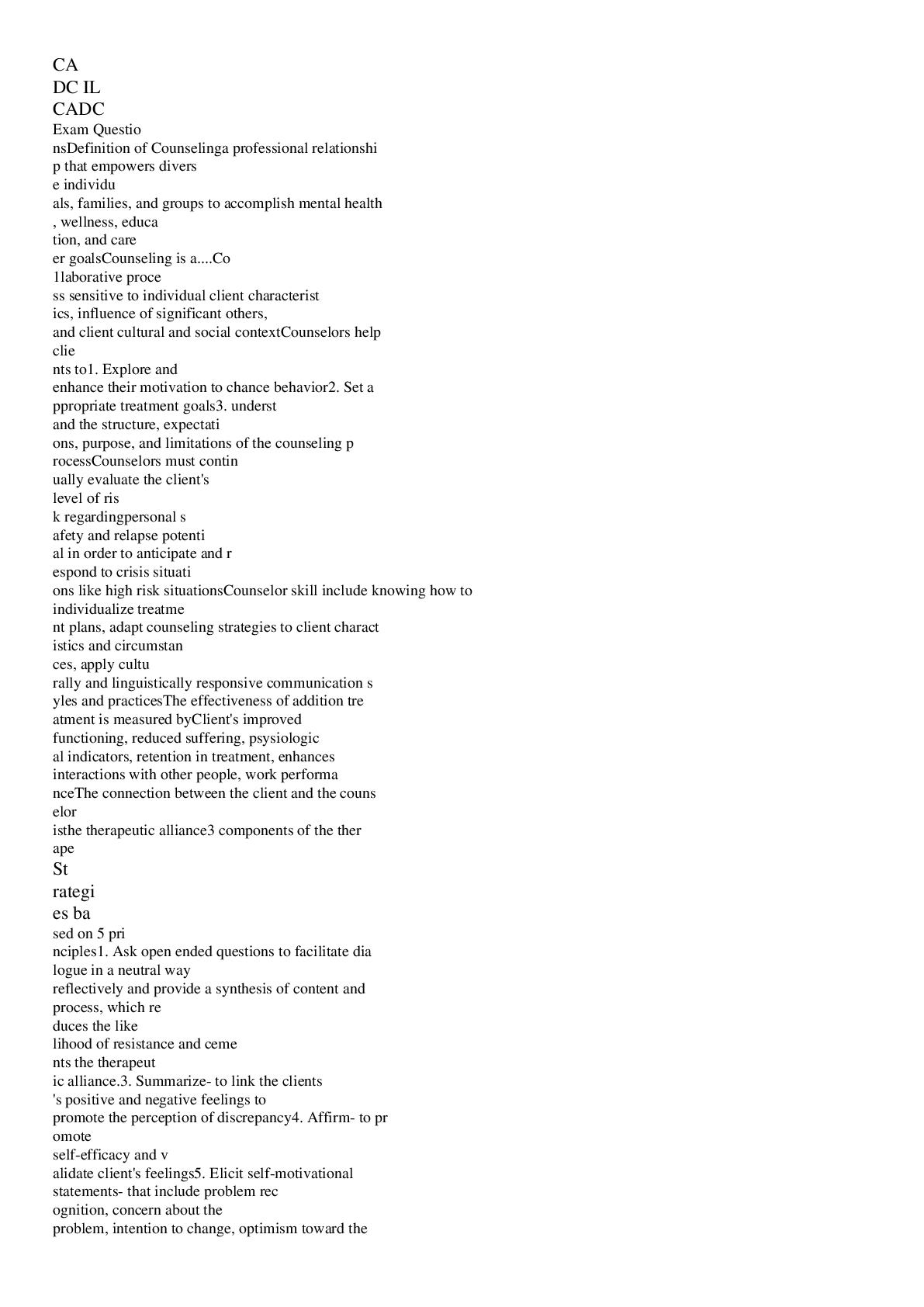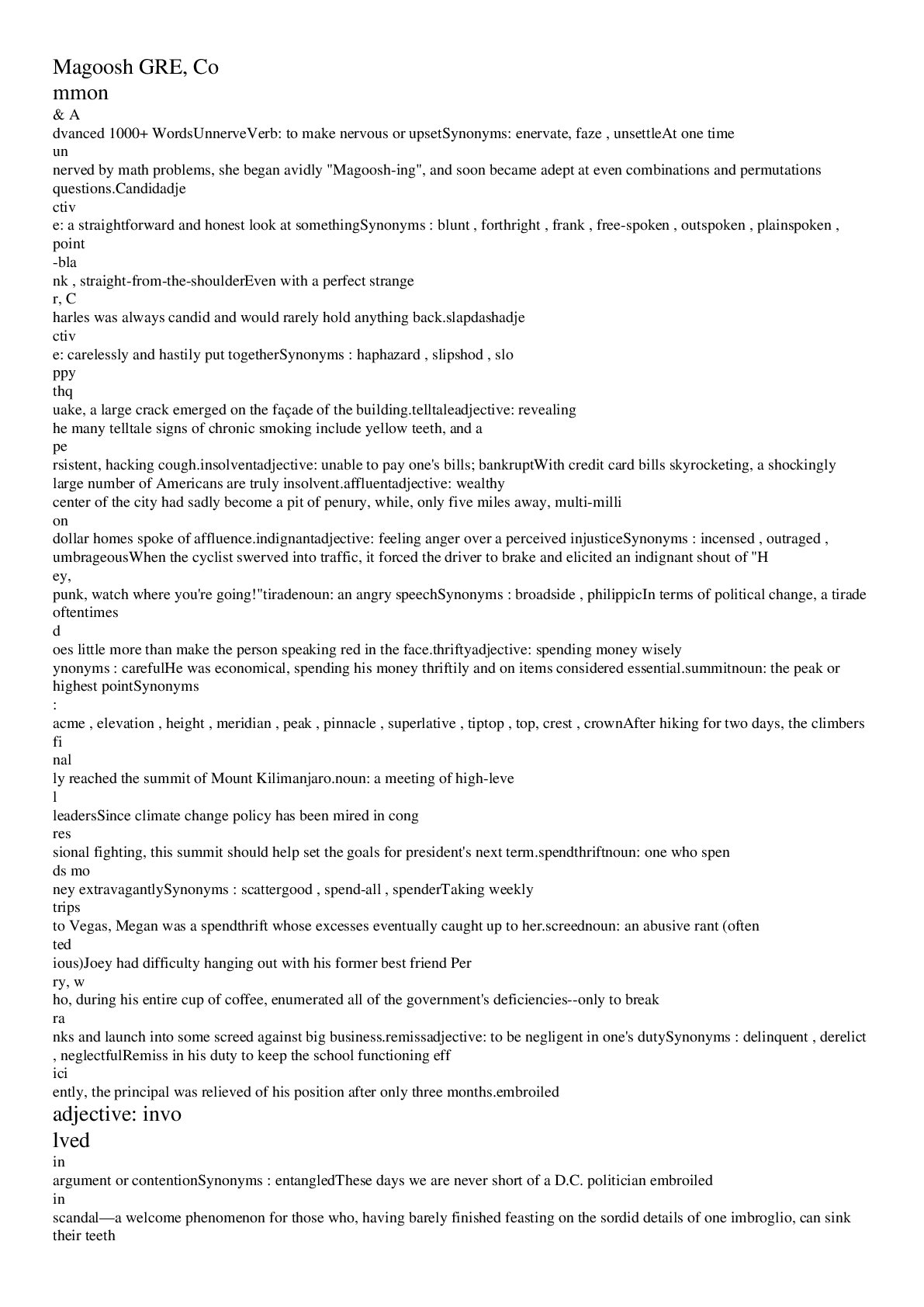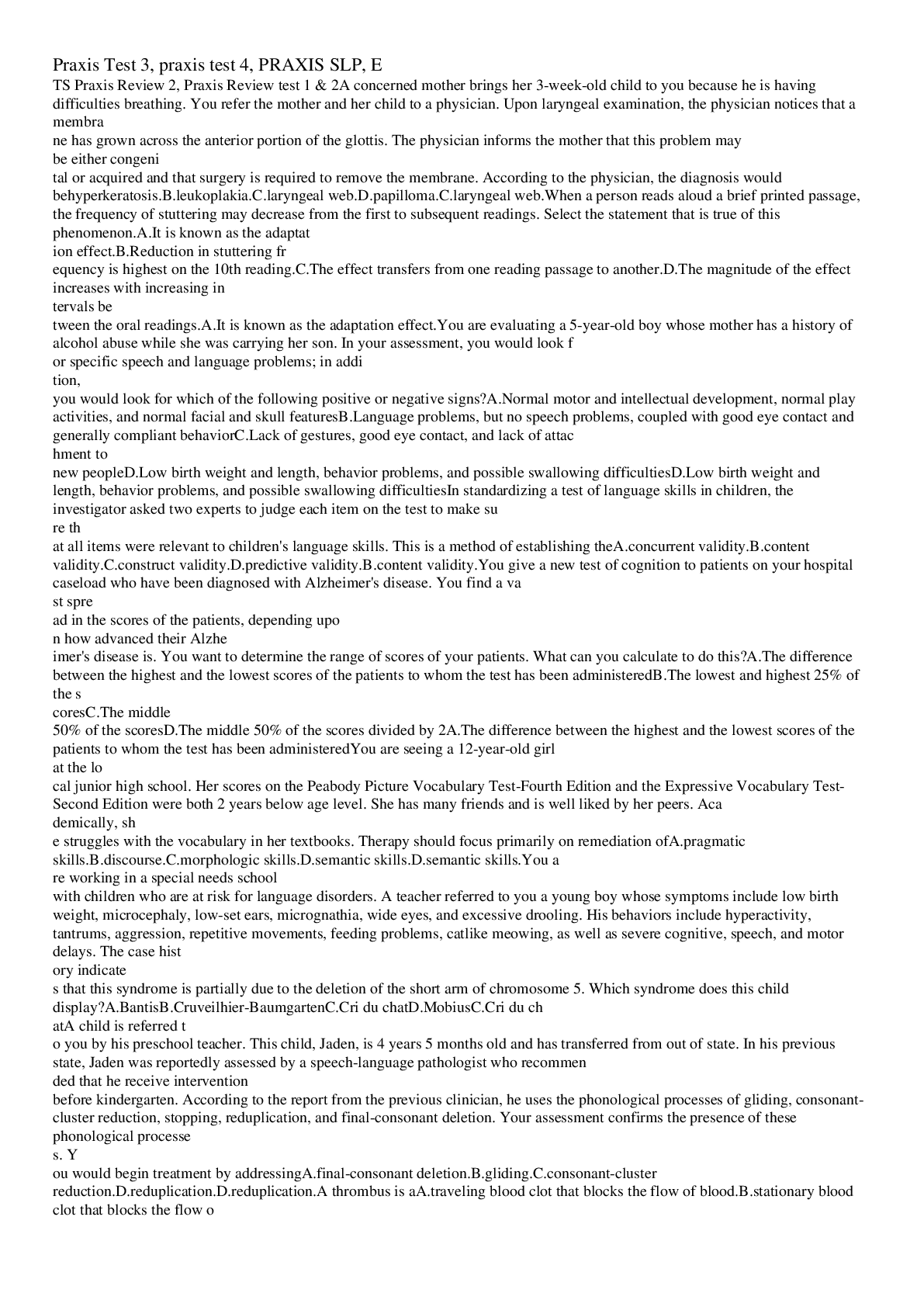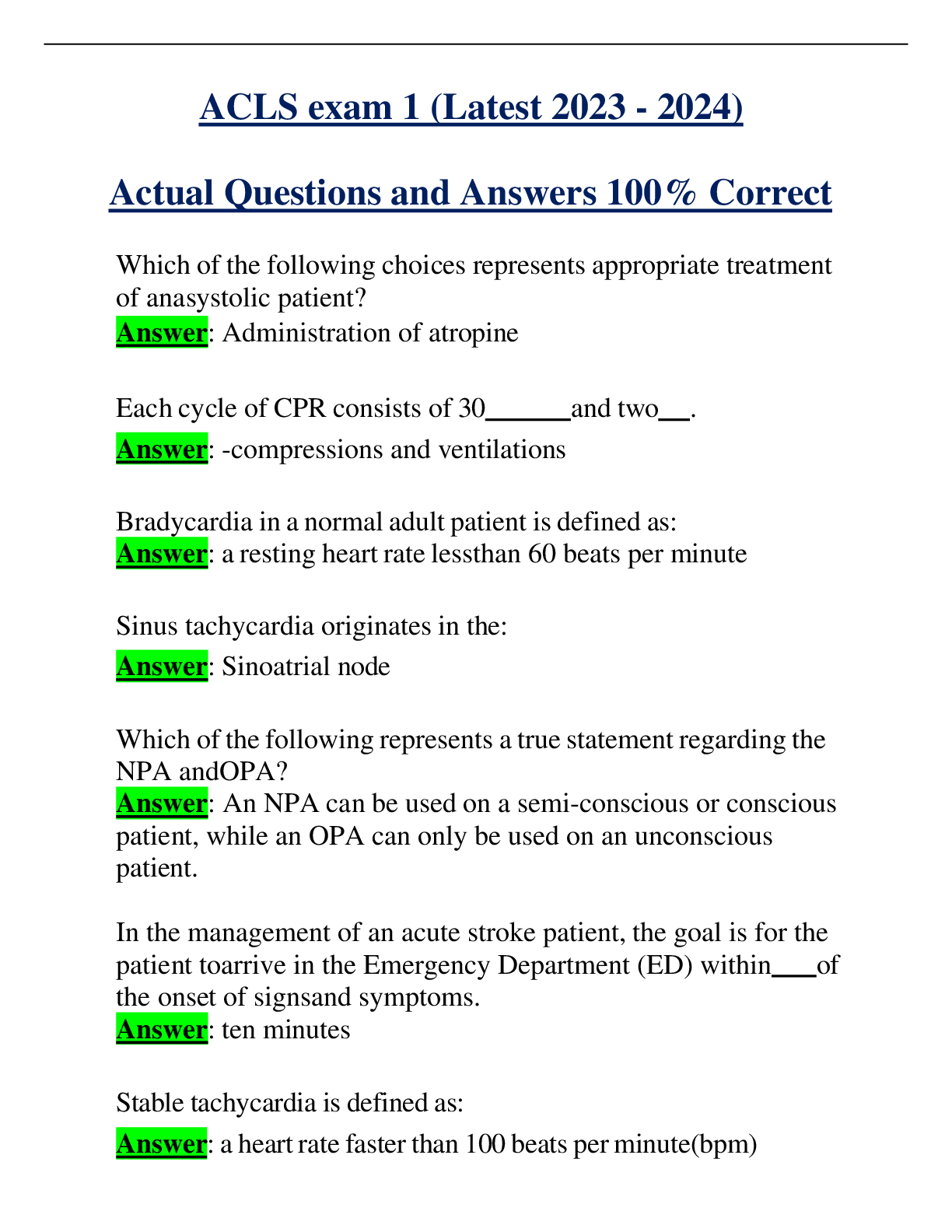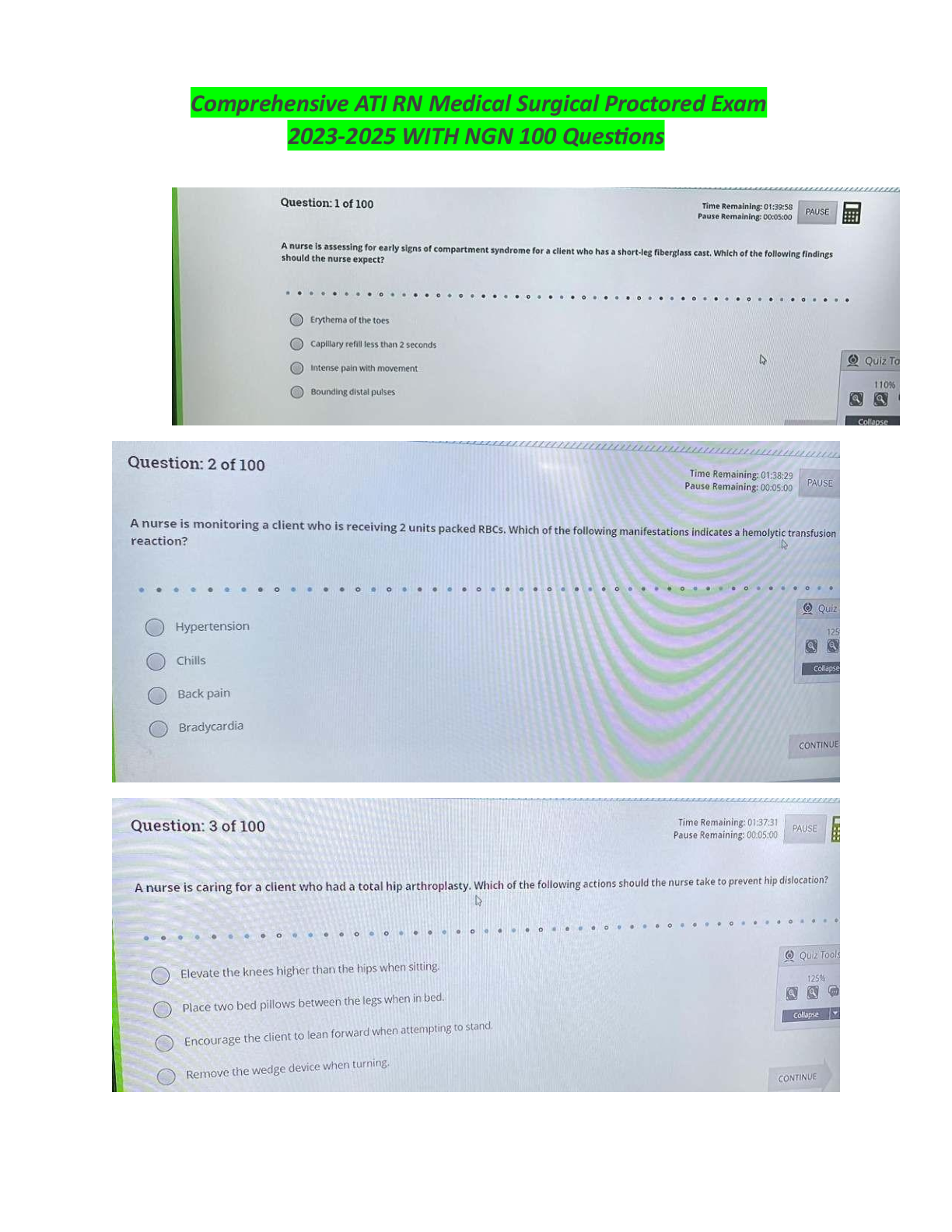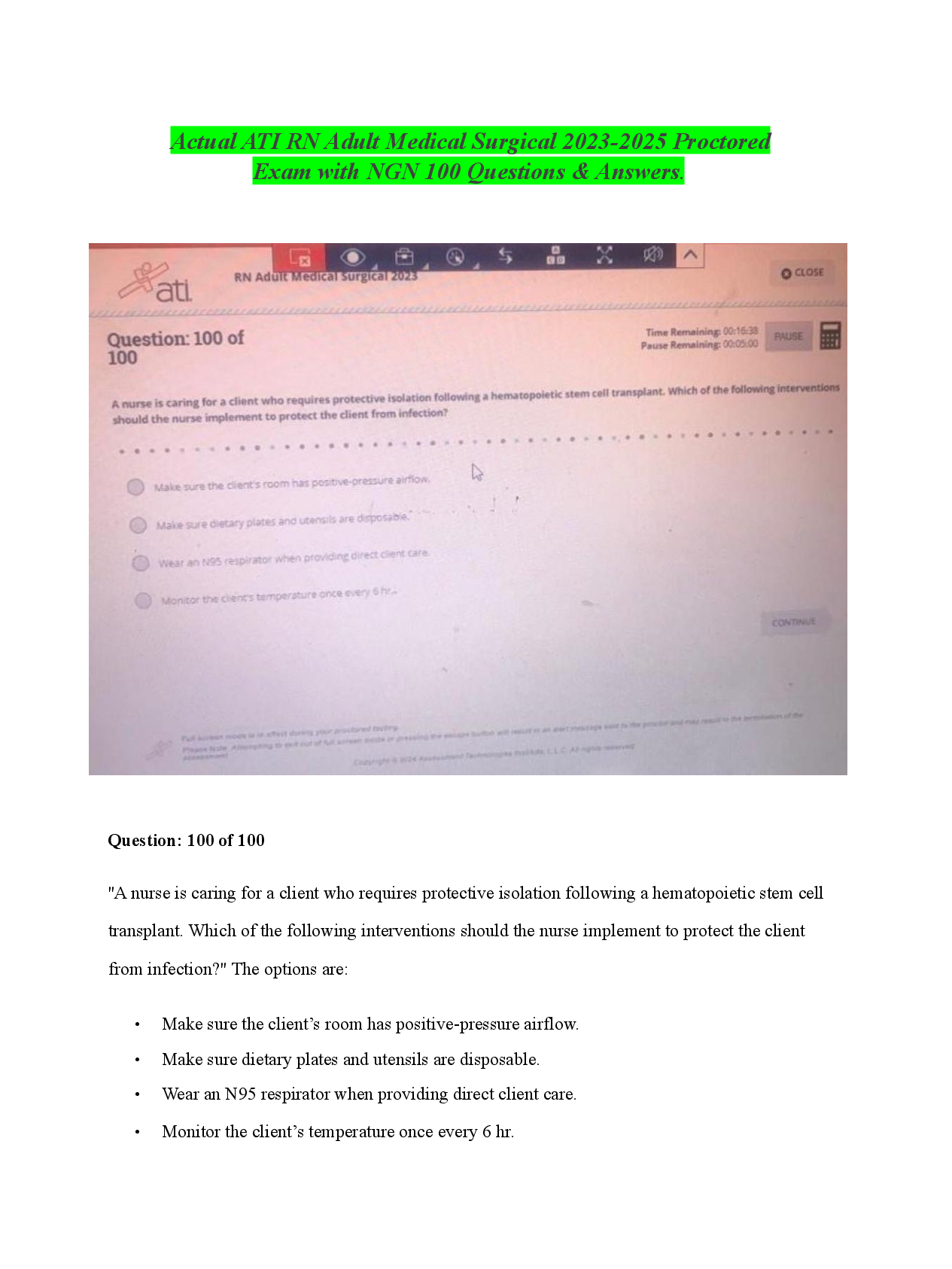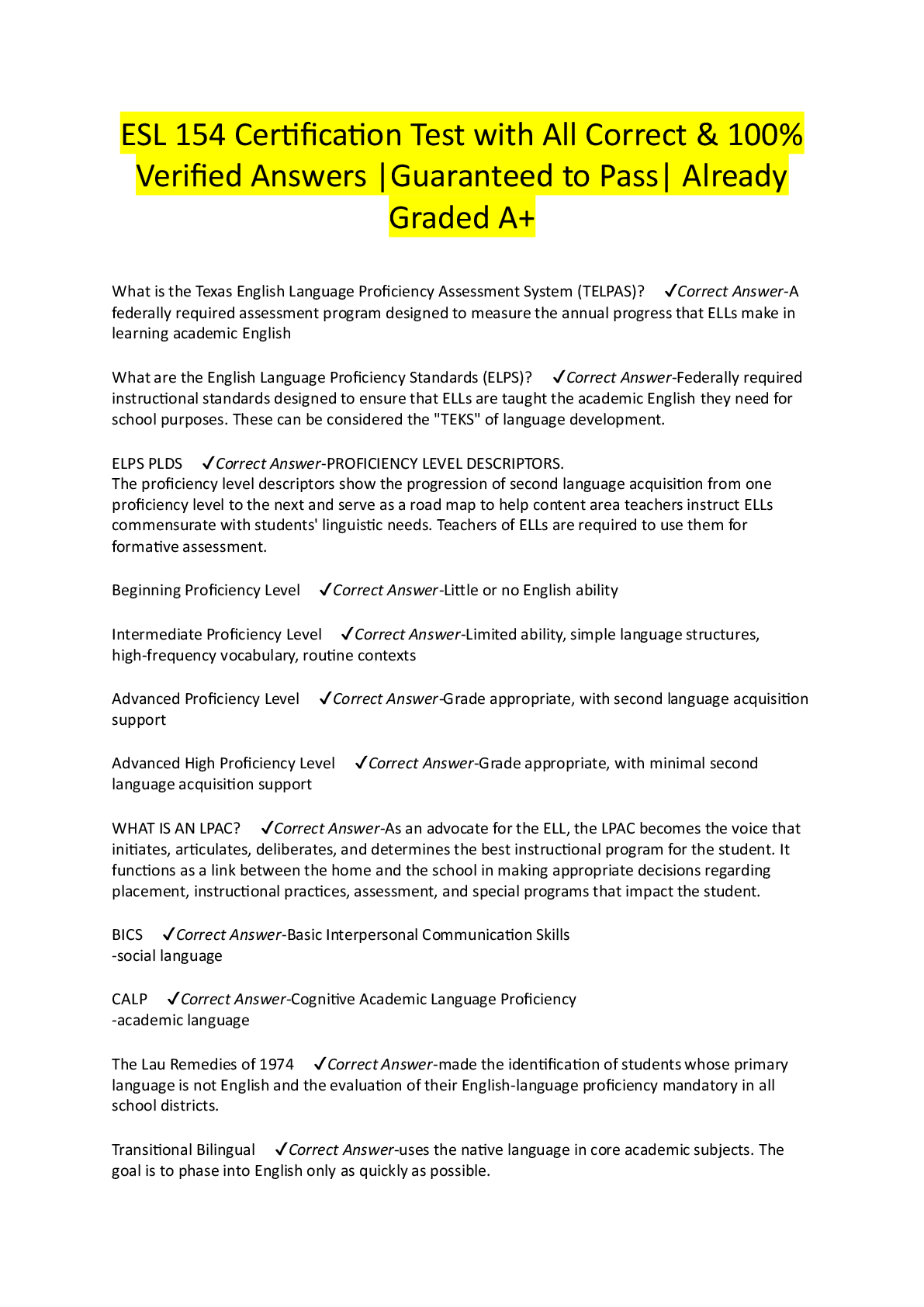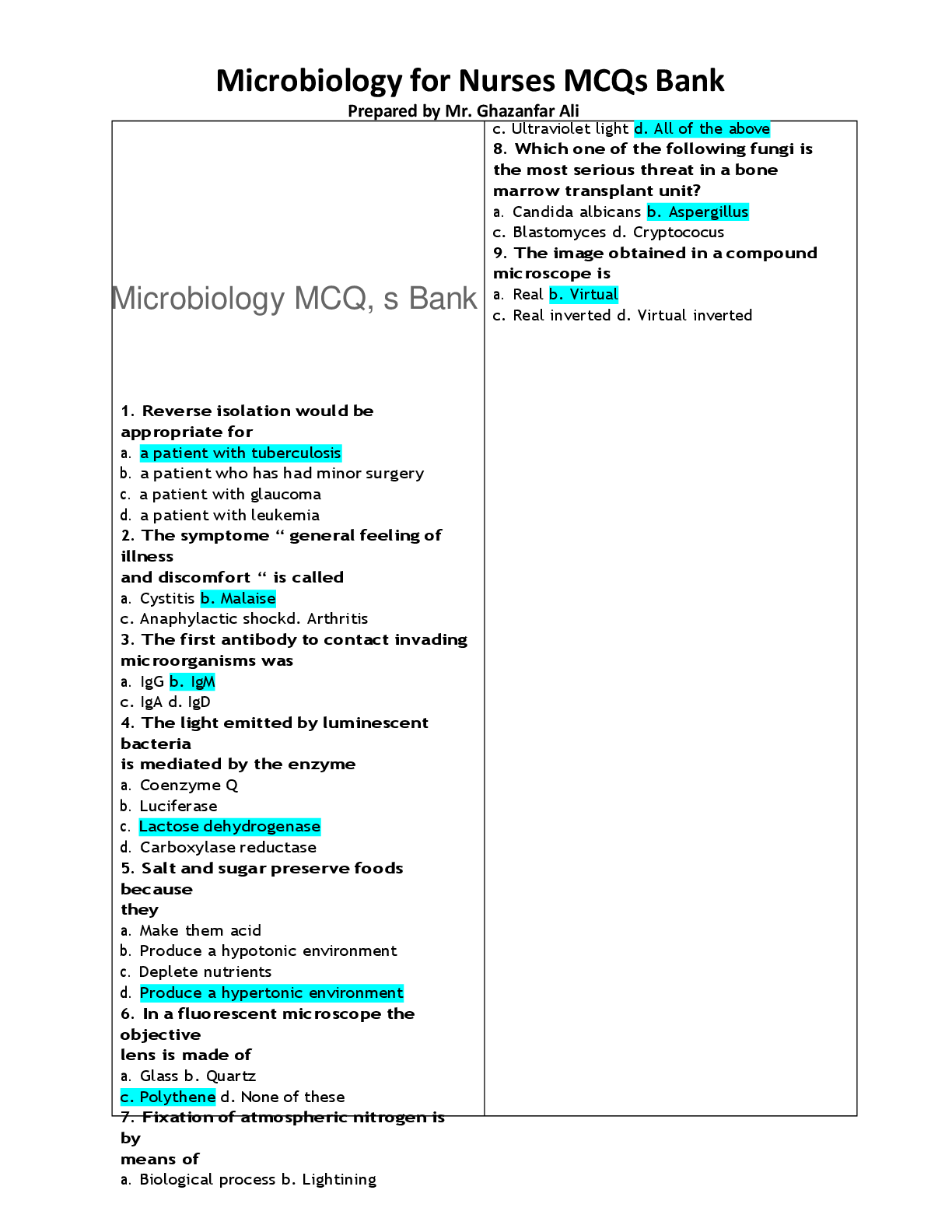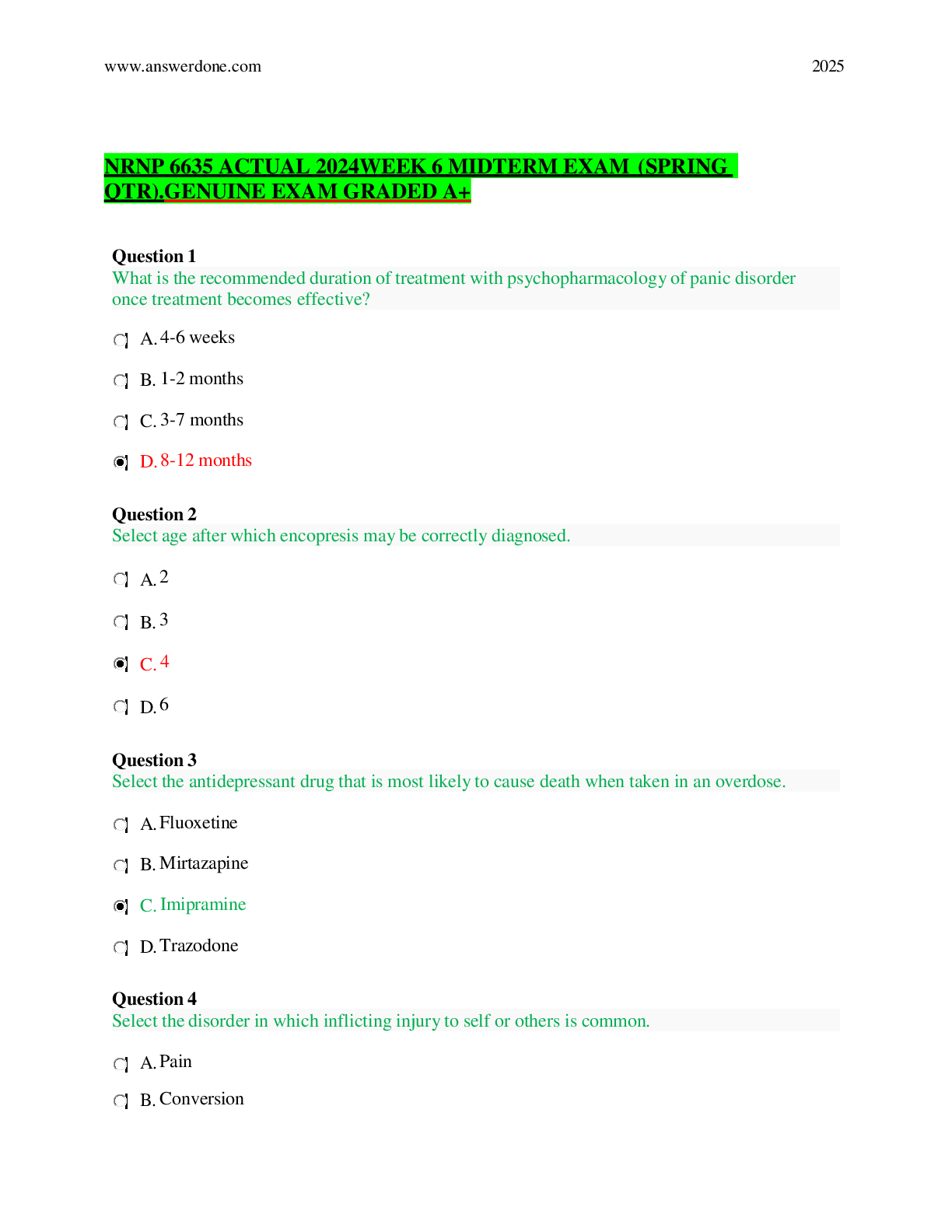Counseling > EXAM > CADC I Exam Prep Questions with Correct Answers #1 (All)
CADC I Exam Prep Questions with Correct Answers #1
Document Content and Description Below
CADC I Exam Prep Questions with Correct Answers #1 CADC I Exam Prep Questions with Correct Answers #1 Characteristics of PCP Phencyclidine recongized as a hallucinogen, can also act as a stimulan ... t & pain killer. Comes in several forms: powder liquid or tablet. Its often combined with other substances such as LSD or marijuana. Has been used medically as an anesthetic on humans as well as hosres. Steet names are "angel dust" & "horse tranquilizer." Characteristics of LSD A hallucinogen so strong one the size of an asprin equals 3000 doses. Street name is "acid" Its white powder can be bought in capsules, tablets, also put in candy, cookies, or absorebed into paper, postage stamps & ink blottters. Benzodiazepines / Tranquilizers Presciption drugs that given to help relieve anxiety and treat some side effects of alcohol withdrawal. Brand names include Valium, Librium, Ativan & Serax. Valium (Diazepam) Best known street drug because its easy to attain & provides a moderate high. Very dangerous when users combine it with alcohol which also depresses the central nervous system. Characteristics of amphetamines Drugs in the stimulant class known as speed, uppers, or bennies. Used medically to treat narcolepsy & ADHD. In the past they were used to treat obesity & depression, but is now against the law to use for these purposes. Characteristics of Opiate Narcorics Usually thought of as pain killing drug or analgesics. These drugs have high potential to cause addiction. The physical effect of use is an intense feeling of well-being & euphoria. They are divided into 2 groups -- natually occurring & synthetic. Morphine & Codeine Opiate narcotics in the natural group & obtained from the opium poppy. Heroin Drug made chemically from morphine. Demerol, Talwin, & Methadone Drugs in the synthetic-group of Opiate Narcotics made in a laboratory. Withdrawal Symptoms of Opiates Stomach cramps, diarrhea, runny nose, tears, yawning, goose bumps, & genneral sense of insecurity. They lessen in severity in a few days, but may take weeks or months to completely subside. Characteristics of Crack Stimulant drug made from cocaine powder street named "rock." Smoking it provides a quicker rush than sniffing cocaine. Use creates euphoria often prescribed as a whole body orgasm, followed vy a crash which includes anxiety, paranoia, & extreme fatigue. Characteristics of Cocaine Stimulant in fine white powder form. Use causes the brain to relase dopamine & norepinephrine causing a euphoric state. Street names include coke snow flake & stardust. Users sniff inject or smoke it known as free basing. Characteristics of Cannabis Mood altering drug made from the flowers of the plant cannabis sativa. Forms include marijuana, hashish & hash Oil. It is usually smoked but can be put into food & eaten. THC / Tetrahydrocannabinol Psychoactive chemical in cannabis which causes its mood altering effects. Hash oil contains up to 60% where as marijuana contains 7-15%. Alcohol A sedative that depresses rhe central nervous system. Effecta include lowering of inhibitions relaxation & inhibition of good judgement decreased reaction time & fine muscle coordination. Short-term effect of PCP Effects vary greatly from person to person because it can act as both a stimulant & depressant. Some find it difficult to concentrate & communicate. Some have a sense of separation from surroundings, confusion, unreal perceptions of time, space & body images. Long-term effects of PCP Known effects include speech problems memory loss depression & anxiety. Flashbacks can occur days or even months after use which may include hallucinations & sensations felt during use. Short-term effects of LSD Effects begin w/in a few minutes & can last as long as 12 hours. Sight hearing & taste can be affected. Causes increase in blood pressure dialated pupils nausea chills & fever numbness & rapid heart beat. Long-term memory is exceptionally clear & strong while short-term memory is almost non-existent. Long-term effects of LSD Effects are most often manifested in flashbacks where all of the short-term effects are experienced all over again. Heavy users are characterized by apathy no interest in the future very little patience or ability to cope with frustration. Also run the risk of developing chronic psychosis. Short-term effects of Tranquilizer use Effects include reduced anxiety tensoin calmness drowsiness slight problems w/ memory & thinking. Fatigue reduced inhibition & clumsiness have also been noted. Long-term effects of Tranquilizers Headaches lack of energy irritability & sexual problems. Abuse can cause problems w/ memory thinking judgement muscle weakness slurring of speech anxiety & insomnia. An overdose can cause coma. Short-term effects of Amphetamines Effect very individually. Increase in blood sugar inability to sleep increased alertness & tremors are all possible. Other side effects might include diarrhea rapid heartbeat increase urine output dry mouth or rapid breathing. Higher dosage use can produce panic depression & irritability . Long-term effects of Amphetamine Insomnia elevated blood pressure skin rashes irregular heartbeat. Eating disorders & nutritional problems result from appetite-suppressant effects. High doses over a long period of time mental problems chronic psychosis which is like paranoid schizophrenia can develop. Short-term effects of Opiate Depends on the amount taken the individual's mood prior to use other drug usage & even the environment. They depress the CNS but stimulate the brain centers. Causes rush of great pleasure after injected. Nausea constipation & drowsiness can occur at low doses. High doses can cause severe respiratory system problems clammy blue skin pin prick pupils & dry mouth. Long-term effects of Opiate Decreased sexual drive menstrual irregularity & constipation. Injection can lead to liver disease AIDS & infections related to dirty needles can occur. Short-tern effects of crack Feeling of euphoria high energy decreased appetite increase heart rate & body temp. Large doses can cause convulsions nausea blood pressure elevation twitching & fever. Overdosing can result in respiratory failure caused by seizures stroke &/or heart failure which can lead to death. Long-term effects of Crack Constipation insomnia impotence &/or weight loss. Lung damage is also possible due to inhalation of the vapors. Because it users get an intense high in a very short time followed by feelings of deep depression addiction often results. Short-term effects of Cocaine Dilation of the pupils rapid heart rate & breathing sweating heightened alertness feeling of confidence & well being. A decrease in appetite can also occur. Heavy use effect are blurred vision high blood pressure hallucinations violent behavior muscle spasms loss of coordination stroke nausea twitching fever & chest pain. Many experience stuffy nose &/or insomnia. Long-term effects of Cocaine Hallucinations weight loss impotence difficultly urinating constipation insomnia restlessness excitability & a suspicious nature. Users are lethargic apathetic & cannot sleep which lead to abuse of other drugs to alleviate symptoms. Short-term effects of Cannabis Relaxation & lowered inhibition after just a few puffs. User may become very talkative or quiet. Increase in the sharpness of the senses & plain everyday items take on special meanings or properties. Attention span & concentration become shorter. Judging distance becomes difficult. Time passage has little meaning. Other effects include red eyes drowsiness balance problems increased appetite & dry mouth. Long-term effects of Cannabis Lung damage apathy failure to set goals difficulty performing simple tasks neglect of personal appearance slow mental responses & difficulty with speech. Inhalants Vapors that are inhaled in order to produce mind-altering effects. They are chemicals most often found in household products. Methamphetamines Chemically made stimulants related to amphetamines but the effects are much greater. Can be injected taken orally snorted or smoked. Methamphetamine Smoking or or injection causes a high or rush that is very pleasurable. Snorting or oral use produces a euphoric high but no rush. Psychoactive Chemical Abuse A faulty adaptation pattern of behavior I which the use of chemicals has led to at least one of the following in a 12 month period: Repeated use resulting in inability to meet responsibilities at work home or school Repeated use in dangerous situations Repeated use leading to legal issues Repeated use despite repeated social or person issues Psychoactive Chemical Dependence A faulty adaptation pattern of behavior in which the use of chemicals has to at least 3 of the following in a 12 month period: Tolerance Withdrawal Increased amount of chemical is taken over a longer period of time Strong desire to reduce or quit use with unsuccessful results Great amount of time is spent getting using & recovering from effects Continued use despite know physical & psychological problems occur Physiological Dependence The body's adaptation to the presence of a chemical. When the chemical is not present the body reacts in a negative manner called withdrawal. Primary or Acute Withdrawal Last from 2-7 days & is characterized by the strongest symptoms usually the opposite of the positive effects of the drug. Secondary or Prolonged Withdrawal Last for weeks or months. Symptoms include nervousness problems sleeping mood swings & changes in body functions. Detoxification The first step of the treatment of substance abuse. The body must be cleansed from the short-term effects of the chemical before treatment can begin. Alcohol & other depressants opiates & cocaine require this. Psychological or Behavioral Dependence When a person takes a chemical to satisfy a feeling or an emotional need. It is described as a craving. It usually appears with the physiological version but not always. Abuse Liability Involves the question "What are the chances or odds of a dangerous drug causing addiction." Controlled Substance Any drug that has an abuse potential and is placed on restricted use by the DEA. Poly-chemical Abuse When more than one psychoactive chemical is used at the same time. Antagonist Psychoactive chemicals that reverse the effects of another drug. Agonist Psychoactive chemicals that enhance the effects of another drug. Schedules I-V The groups that drugs are put into according to their: abuse liability medical usefulness History of use & a use Risk to public health political considerations. Schedule I Drug that have no medical use & high abuse potential. They include: heroin, LSD, marijuana, peyote, psilocybin, mescaline, & MDMA. Schedule II Drugs with a high abuse potential with severe psychic or physical dependence liability even though they have medical uses. These include: methamphetamine, opium, morphine, hydromorphone, codeine, meperidine, oxycodone, & methylphenidate. Schedule III Drugs with less abuse potential. This class includes Schedule II drugs when used in co pounds with other drugs. They include: Tylenol w/Codeine, some Barbiturate compounds, & paregoric. Schedule IV Drugs that have even less abuse potential. They include choral hydrate, meprobamate, fenfluramine, diazepam (Valium), & other benzodiazepines & phenobarbital. Schedule V Drugs with very low abuse potential because they contain vet limited quantities of narcotic & stimulant drugs; some are sold OTC. Robitussin AC (DXM), & Lomotil are 2 examples. Cross Dependence Substituting drugs for each other w/in the body and preventing withdrawal &/or similar drugs persevering the state of dependence. Dependence A compulsive pattern of drug use involving getting a supply, extreme involvement in use, & high relapse occurrences after withdrawal. Detoxification When cross dependent chemicals are substituted for the chemical which being abused together with a slow withdrawal of that chemical. Stage1 Depresent Withdrawal Stage of Depresent Withdrawal characterized by shakes. 90% of patients experience flushed face, nausea, disorientation & inability to sleep. The worst occurs from 24-36 hours after the last drink. Stage2 Depresent Withdrawal Stage of Depresent Withdrawal characterized by hallucination. About 25% of patients experience perception from shadows & movements. In addition, objects can look distorted or unreal. Stage 3 Depresent Withdrawal Stage of Depresent Withdrawal characterized by seizures. Patients may experience Grand Mal(full body) seizures. They occur between 7 & 48 hours. After last drink. Stage 4 Depressant Withdrawal Stage of Depresent Withdrawal characterized by Delirium Tremens (DT). Patients can experience agitation, hallucinations, fever, dilated pupils, delusions, extreme confusion, sleep disorders, tremors, profuse sweating & tachycardia. Occurs in 3-5 days after last drink. Stage 1 Alcohol Withdrawal Stage of alcohol withdrawal characterized by increased blood pressure, pulse & temp. Limited attention span, state of anxiety, sleeplessness, nausea, vomiting, shake, speech is slurred, walking is unsteady, & frequent urination. Stage 2 Alcohol Withdrawal Stage of alcohol withdrawal characterized by hallucinations evidenced by fearful state; distraction &/or disorientation, Grand Mal seizures are possible. DT's develop evedenced by an extreme agitated state, confusion, incontinence, extreme psychomotor activity, talking to people who are not there, & uncooperative behavior. Dependent Delusional System The way a person protects the inner person from the realization of their dependency on drugs. Dependent Delusional System Memory & recall are 1 part of this system. Characterized by Repression when feelings &/or incidents are blocked from memory. Dependent Delusional System Denial is the 2nd part of this system. Simple denial includes telling lies to self & others. Rationalizing to justify use; Projecting and blaming to try to make others responsible for use: & Intellectualizing Rationalization Using a logical excuse as a means of justification for use. Intellectualizing Looking at life from an intellectual view, but defying feelings & emotions. Treatment Applications for Alcohol Withdrawal Increase sedation; monitor fluids; electrolytes; & vital signs; observe & provide a quiet, well-lit room. Do not try to reason w/ the patient or provide any therapy; act w/ kindness & gentleness; behave calmly; orient patient back to reality; no moralizing or blaming; & close doors to cut down on shadows. Alcohol Detoxification This is usually provided in a hospital setting & normally last no more than 5 days. Access to medical supervision is important so that nutrition, fluid, & electrolyte level, & medication can be monitored. Disulfiram (Antabuse) A pharmacotherapy for alcohol dependence. The medication make people sick if they use alcohol. Must be taken every day, which may be difficult for some. Its effectiveness as a treatment is cry good because of the effects produce after consuming alcohol. Naltrexone A pharmacotherapy for alcohol was known as Trexan but is now called ReVia. Works by reducing the craving mechanism for alcohol. Other steps can be taken in conjunction which increase the the effectiveness. These include development of coping skills , prevention of relapse, & use of support groups. Barbiturate Withdrawal The most important part of withdrawal from this substance is the possibility of the occurrence of blood pressure and breathing problems. They must be treated immediately or the situation can become life threatening . Normal symptoms include: increased heart rate, abdominal crapping, nausea & vomiting, sweating, & shakes. There are incidents during peak withdrawal of severe seizures, unconftolled heartbeat, delirium, & even death. Treatment Applications for Barbituates Detoxification must this substance must take place under medical supervision because of the high risk of life-threatening episodes. Client's treatment plan needs to include extended care because their education & performance capabilities are impaired during normal treatment stay. Client & family education about substance is necessary. The need for support system be stressed. Coping skills a& decision-making skills should be taugh. Alternative ways to relax & get to sleep should be introduced. Ways to work with shame, fear, & grief should be taught to help client move toward sobriety. Benzodiazepines Usually known as tranquilizers. They are used for treating anxiety. They target anxiety rather than being general depressants. Rational-Emotive-Behavioral Theory (REBT) Based on the principle that people are not disturbed by events but rather how they see the event. Attitudes & negative self-concepts can start& maintain the process of addiction. REBT concentrates on the here and now rather than the past as to how a person's attitudes, beliefs & self-concepts affect their emotions & behavior. One of the beliefs of this model is that motivations that caused self defeating behaviors of chemical addictions are discomfort, anxiety, & low frustration tolerance. The counselor's job is to help the patient replace these behaviors with rational behaviors. A B C Model of REBT A - Activating event. B - Beliefs & thoughts. C - Consequences ( both emotional & behavioral) Behavioral Modification Theory Based on the idea that all behavior is learned; and what is learned can be unlearned. Learning processes are are tied to the cause, support, & change of behavior & include: Classical Conditioning, Operant Conditioning, & Modeling. Classical Conditioning Substituting a stimulus which brings about the same result. Operant Conditioning Based on the increase or decrease of certain behaviors through the use of reinforcement. Negative reinforcement can decrease behavior. Modeling Learning behavior by observing another performing the behavior. Then a practice of the behavior occurs followed by reinforcement. Control Theory / Reality Theory An approach to counseling which has its base on the idea that it's not the real world that affects one's behavior. Rather it's how the world is perceived to be. Another principle is that people don't have to be a victim of what has happened in the past unless they let it. 4 Parts of Control Theory / Reality Theory The 4 parts of this theory are doing, thinking, feeling, & physiology. This means that the patient has the power to change the way they act & think. Another underlying principle is the emphasis on taking responsibility for satisfying one's needs w/out interfering with the needs of others. A focus is on client changing his total behavior not just his attitudes & feelings. Person Centered Therapy This therapy is made up of provisional ideas. One is its the patients responsibility to find ways to deal reality. Counsellor's job is to try to understand how the patient sees them self as well as the world. An accepting, genuine & empathetic counselor may bring this out. Can decrease defensiveness as well as help client see themselves as they really are. Freudian or Psychoanalytical Therapy Therapy based on the idea that people are influenced considered by their unconscious & inner-drives. Conflict is caused by 3 systems interacting. The source of unconscious drives is called the id. The internalized outside world is called the superego. Anxiety is created when there is conflict between the id & the superego. The 3rd system, the ego takes the force of the conflict. This results in the creation of defense mechanisms such as denial. This therapy is helpful when there are many relapses. & serious personality disturbances. Adlerian or Individual Therapy Therapy based on the idea that people are always striving to be better or perfect. It is often thought of as a Growth Model. Developer believed that social urges were what influenced people. When levels of improvement or perfection aren't reached, a feeling of inferiority is felt & dissatisfaction is present. Fictional Finalism Part of Adlerian Therapy. A term that refers to everyone having a goal that provides a purpose. Sometimes it can be negative & lead to chemical abuse. Gestalt Therapy Therapy based on the idea that people must accept responsibility for what happens to them & find their own way in life. It only deals with the present. One important principle is to help the patient discover what they want to be rather than trying to be someone else. This therapy stresses living with one's feelings rather than running away, even if the feelings make one uncomfortable. Solution Focused Therapy Therapy that focuses on what works rather than problems. The idea is to work with the beliefs of e patient to promote change. Pharmacotherapy Using prescription drugs along with some form of therapy to treat substance abuse. Research has shown it to be very successful. Sensitizer A form of Pharmacotherapy where a medication like Antabuse causes unpleasant effect if used with the substance being abused. . Neural Blockers A form of Pharmacotherapy where A medication acts as an antagonists which blocks the effects of the abused drug. Family Systems & Addiction Counseling Based on the premise that when a person abuses drugs; the whole family is affected. Several models of therapy are being used. Dynamic Family Therapy Based on gaining insight to be able to understand conflicts which are present in the family setting. Experiential/Humanistic Family Therapy Based the present and the most important factor of recovery is self- determination & self-awareness. Bowenian Family Therapy Based on the concept that emotions & intellect of a family are entangled or fused. This causes an automatic emotional arousal w/in the family. The other basis is referred to as differentiation where the individual remains w/out outside control. Structural Family Therapy When the counselor tries to change the dysfunctional structure of the family. Family Disease Model Based on the idea that alcoholism is a family disease & the disease itself is codependence. Twelve Steps of AA / NA We are powerless over alcohol/ drugs & our lives are unmanageable A power greater than ourselves can restore our sanity Make a decision to turn things over to God Make a thorough moral inventory Admission of wrong to self, another, & God Ready to get rid of character defects Ask God to remove shortcomings Make a list of people hurt & become willing to make amends Make amends to people on list Continue to make personal inventories & admit wrongs Pray for knowledge of God's will & power to carry it out Try to carry the message to others & to practice all these steps Deductive Reasoning The ability to solve problems by working from a given situation to a conclusion. Inductive Reasoning The ability to solve problems by working from a specific experience to a conclusion. Adolescent Egocentrism Self-centeredness based on the concern about what others think. Identity Formation A process that a person goes though in becoming a distinctive individual. Identity Achievement Occurs when a person sets a goal based on their values. Taxonomy of Pathology The classification of problems into 2 groups called Axis I disorders which include behavioral disorders as well as some physical disorders & Axis II disorders which are only behavioral. Motivational Enhancement Therapy Therapy based on motivational psychology. Change is internally motivated & very rapid because it is based on the belief that the patient has the capability as well as the responsibility to change. There is an emphasis on Persian choices regarding drug use together with an objective evaluation of behavior. Pre contemplation Change has not or is not being considered. Contemplation Thoughts begin to occur about the possibility of change together with what the cost will be. Determination / Planning A decision is made to change. Action Behaviors are changed. Maintenance Things that made the change possible need to be maintained. Ambivalence The feeling of contradictory emotions or feelings at the same time for an object or person. Codependency A condition where another individual such as a spouse or family member is controlled by the addictive behavior of the addict. Acceptance, security, love, & approval all hinge on behaving in the way the addict wants. Enabling Behavior This occurs when another individual such as a codependent encourages the addict to continue drug use. This behavior can occur both directly & indirectly. Examples of this include: a spouse lying regarding the addiction or giving money to the addict allowing them to buy drugs; or covering up of the addiction of a spouse to protect the children. Shame The negative feeling which refers to what the addict believes about them-self. Guilt Has to do with the belief that the addict has done something wrong. Transference A situation wherein a client transfers how they feel about important people in there life to the counselor. This can cause a problem in how the client sees & responds to the counselor. Countertransference n. [Show More]
Last updated: 1 year ago
Preview 1 out of 6 pages
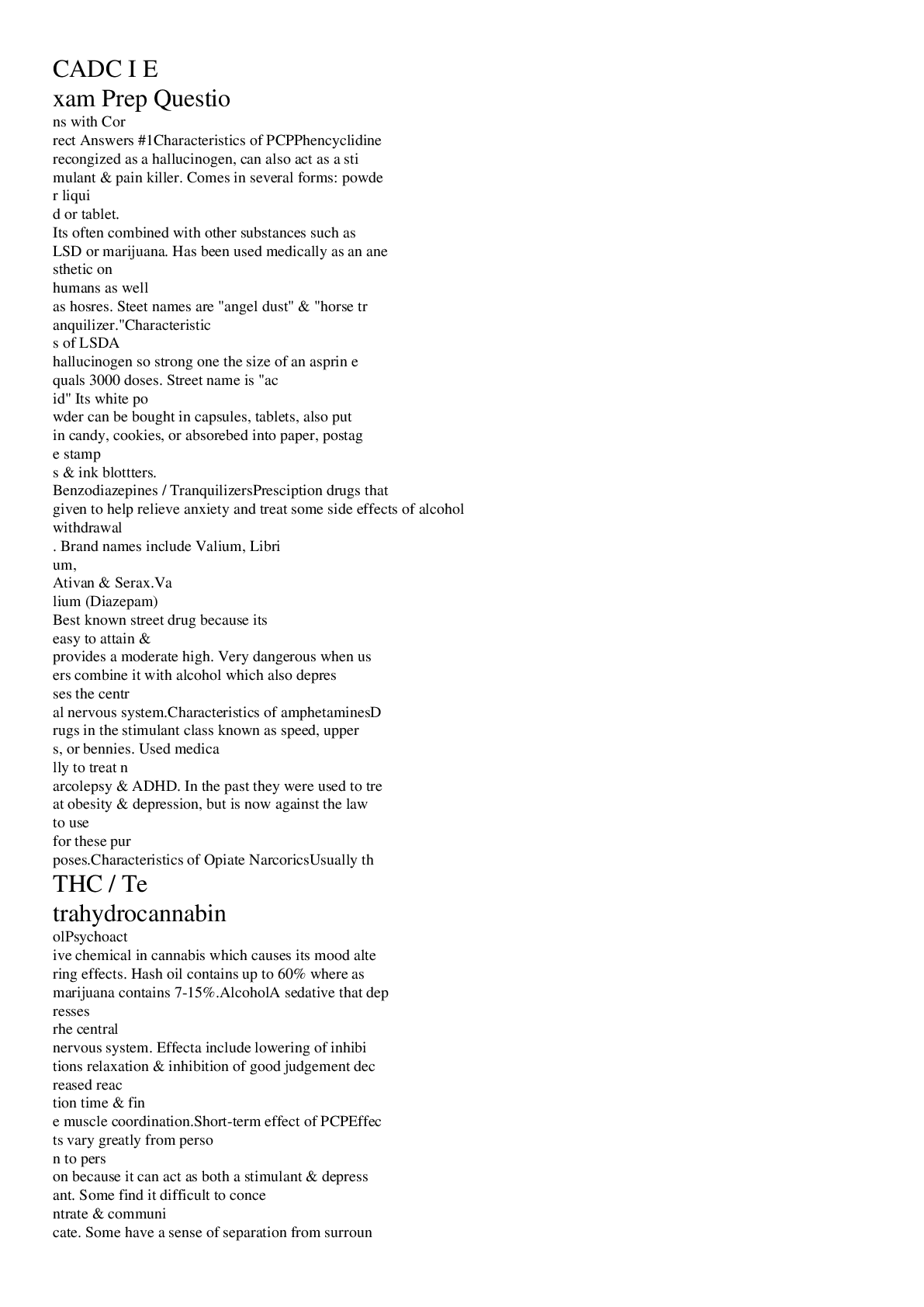
Buy this document to get the full access instantly
Instant Download Access after purchase
Buy NowInstant download
We Accept:

Reviews( 0 )
$10.00
Can't find what you want? Try our AI powered Search
Document information
Connected school, study & course
About the document
Uploaded On
Oct 16, 2022
Number of pages
6
Written in
All
Additional information
This document has been written for:
Uploaded
Oct 16, 2022
Downloads
0
Views
127

